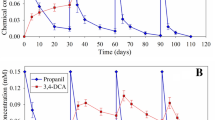Abstract
The microbial degradation of monochloro-, 1,2-dichloro-, 1,4-dichloro-, and 1,2,4-trichlorobenzene in soil slurries was examined with single compounds as well as in mixtures. The indigenous soil populations brought about the degradation of monochlorobenzene when incubated at 27°C in slurries with 29% (w/w) suspended solids. In contrast, the other chlorobenzenes persisted during an incubation period of 1 month. Supplementation with buffer, mineral salts and acetate did not significantly influence the degradation. However, inoculation withPseudomonas aeruginosa strain RHO1, a monochloro- and 1,4-dichlorobenzene-degrading organism, to a titre of 1 × 105 cells/g soil, led to rapid and complete degradation of 0.8 mm growth substrate within 30 h. In addition, the strain was able to degrade 1,2-dichloro- and 1,2,4-trichlorobenzene with stoichiometric release of chloride in the presence of acetate, ethanol, monochloro- or 1,4-dichlorobenzene as growth substrates. In mixtures of chlorobenzenes the co-metabolism of 1,2-dichloro- and 1,2,4-trichlorobenzene occurred until the growth substrates monochloroand 1,4-dichlorobenzene were degraded. The degradation was faster in the slurries of garden soil containing 8% organic carbon than in soil with the lower content of 2.6%.
Similar content being viewed by others
References
Ballschmiter K (1992) Transport and fate of organic compounds in the global environment. Angew Chem Int Ed Engl 31:487–515
Banerjee S (1984) Solubility of organic mixtures in water. Environ Sci Technol 18:587–591
Brunner W, Sutherland FH, Focht DD (1985) Enhanced Biodegradation of polychlorinated biphenyls in soil by analog enrichment and bacterial inoculation. J Environ Qual 14:324–328
Brunsbach FR, Reineke W (1993a) Degradation of chlorobenzoates in soil slurry by special organisms. Appl Microbiol Biotechnol 39:117–122
Brunsbach FR, Reineke W (1993b) Degradation of chloroanilines in soil slurry by specialized organisms. Appl Microbiol Biotechnol 40:402–407
Comeau Y, Greer CW, Samson R (1993) Role of inoculum preparation and density on the bioremediation of 2,4-D-contaminated soil by bioaugmentation. Appl Microbiol Biotechnol 38:681–687
Dorn E, Hellwig M, Reineke W, Knackmuss H-J (1974) Isolation and characterization of a 3-chlorobenzoate degrading pseudomonad. Arch Microbiol 99:61–70
Fisk CF, Noyes WA Jr (1936) Photochemical studies. XXIV. The photochemical chlorination of the dichlorobenzenes. J Am Chem Soc 58:1707–1714
Fletcher CL, Kaufman DD (1980) Effect of sterilization methods on 3-chloroaniline behavior in soil. J Agric Food Chem 28:667–671
Fritz H, Reineke W, Schmidt E (1992) Toxicity of chlorobenzene onPseudomonas sp. strain RHO1, a chlorobenzene degrading strain. Biodegradation 2:165–170
Greer LE, Shelton DR (1992) Effect of inoculant strain and organic matter content on kinetics of 2,4-dichlorophenoxyacetic acid degradation in soil. Appl Environ Microbiol 58:1459–1465
Havel J, Reineke W (1993) Degradation of Aroclor 1221 in soil by a hybrid pseudomonad. FEMS Microb Lett 108:211–218
Hsu T-S, Bartha R (1974) Biodegradation of chloroaniline-humus complexes in soil and culture solution. Soil Sci 118:213–220
Koch R (1991) Umweltchemikalien. Physikalisch-chemische Daten, Toxizität, Grenz- und Richtwerte, Umweltverhalten, 2nd ed. VCH, Weinheim
Kohler F, Rott E (1954) Zur Thermodynamik binärer Mischungen von Komponenten gleichen Molvolumens. Monatsh Chem 85:703–718
Lang E, Viedt H, Egestorff J, Hanert HH (1992) Reaction of the soil microflora after contamination with chlorinated aromatic compounds and HCH. FEMS Microb Ecol 86:275–282
Marinucci AC, Bartha R (1979) Biodegradation of 1,2,3- and 1,2,4trichlorobenzene in soil and in liquid enrichment culture. Appl Environ Microbiol 38:811–817
Meer JR van der, Roelofsen W, Schraa G, Zehnder AJB (1987) Degradation of low concentrations of dichlorobenzenes and 1,2,4-trichlorobenzene byPseudomonas sp. strain P51 in nonsterile soil columns. FEMS Microb Ecol 45:333–341
Miller MM, Ghodbane S, Wasik SP, Tewari YB, Martire DE (1984) Aqueous solubilities, octanol/water partition coefficients, and entropies of melting of chlorinated benzenes and biphenyls. J Chem Eng Data 29:184–190
Oldenhuis R, Kujik L, Lammers A, Janssen DB, Witholt B (1989) Degradation of chlorinated and non-chlorinated aromatic solvents in soil suspensions by pure bacterial cultures. Appl Microbiol Biotechnol 30:211–217
Oltmanns RH, Rast HG, Reineke W (1988) Degradation of 1,4-dichlorobenzene by enriched and constructed bacteria. Appl Microbiol Biotechnol 28:609–616
Pfarl C, Ditzelmüller G, Loidl M, Streichsbier F (1990) Microbial degradation of xenobiotic compounds in soil columns. FEMS Microb Ecol 73:255–262
Rosenberg A, Alexander M (1980) Microbial metabolism of 2,4,5trichlorophenoxyacetic acid in soil, soil suspensions and axenic culture. J Agric Food Chem 28:297–302
Sabljić A (1984) Predictions of the nature and strength of soil sorption of organic pollutants by molecular topology. J Agric Food Chem 32:243–246
Shiu WY, Mackay D (1986) A critical review of aqueous solubilities, vapor pressures, Henry's law constants, and octanol-water partition coefficients of the polychlorinated biphenyls. J Phys Chem Ref Data 15:911–929
Travis CC, Dennison JW, Arms AD (1987) The extent of multimedia partitioning of organic chemicals. Chemosphere 16:117–125
Weissenfels WD, Klewer H-J, Langhoff J (1992) Adsorption of polycyclic aromatic hydrocarbons (PAHs) by soil particles: influence on biodegradation and biotoxicity. Appl Microbiol Biotechnol 36:689–696
Author information
Authors and Affiliations
Rights and permissions
About this article
Cite this article
Brunsbach, F.R., Reineke, W. Degradation of chlorobenzenes in soil slurry by a specialized organism. Appl Microbiol Biotechnol 42, 415–420 (1994). https://doi.org/10.1007/BF00902751
Received:
Accepted:
Issue Date:
DOI: https://doi.org/10.1007/BF00902751




